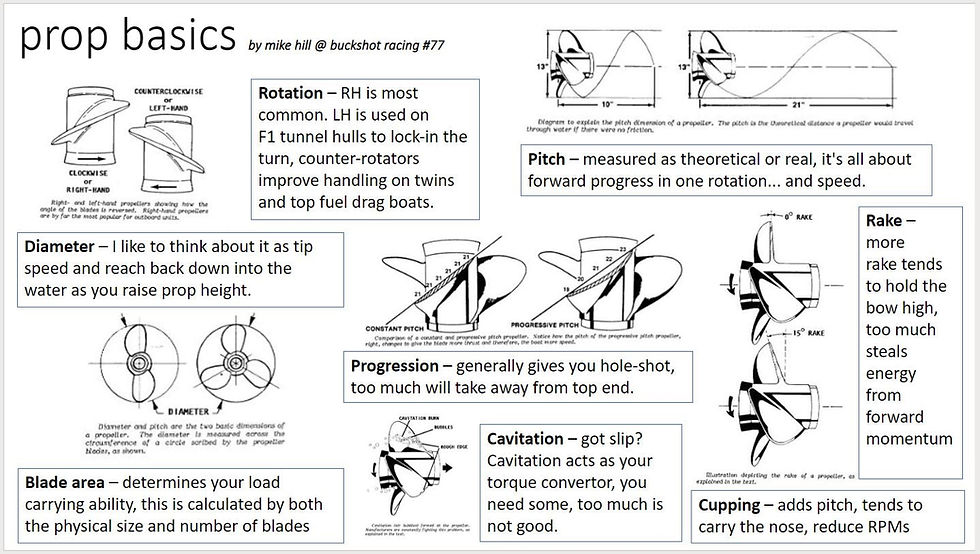Propeller Pitch & Lower Unit Gear Ratios
- Mike Hill
.JPG/v1/fill/w_320,h_320/file.jpg)
- Sep 7, 2023
- 3 min read
Updated: May 20

When tuning a boat for optimal performance, one of the most overlooked yet crucial aspects is how a change in gear ratio affects propeller pitch. If you’re changing your lower unit or modifying your gear ratio, you’ll likely need to adjust your propeller pitch to maintain the correct RPM range and overall efficiency.
Understanding Gear Ratios and Propeller Pitch
The gear ratio in an outboard or sterndrive engine represents the number of engine rotations required to turn the propeller once. For instance, a 1.75:1 gear ratio means the engine must turn 1.75 times for every propeller rotation. A higher gear ratio (numerically) reduces propeller RPM at a given engine speed, which increases torque but reduces speed.
This shift requires a higher pitch propeller to maintain the same speed and RPM balance. Conversely, a lower gear ratio (numerically) means the propeller spins faster at the same engine RPM, and you must reduce pitch to avoid over-revving.
Gear Ratio Change: 1.60 to 1.75
Switching from a 1.60 to a 1.75 gear ratio increases the numerical ratio, which slows down the propeller at the same engine RPM. This change results in an approximate RPM increase of 586.
To maintain the same water speed and engine efficiency, you’ll need to increase your propeller pitch by about 2.81 inches. In real-world terms, that equates to increasing the pitch by 2 to 3 sizes, such as moving from a 30-pitch to a 32 or 33-pitch propeller.
Gear Ratio Change: 1.75 to 1.87
If you go from a 1.75 to a 1.87 gear ratio, the engine will need to turn more times for each propeller revolution, which again lowers prop shaft speed. This causes an approximate increase of 470 RPM.
The pitch needs to be increased by 2.06 inches, or roughly 2 sizes, to compensate for the change. A typical adjustment would be switching from a 30-pitch prop to a 32-pitch to maintain consistent RPMs and speed.
Gear Ratio Change: 1.87 to 2.10
A jump from 1.87 to 2.10 is more significant and results in the largest RPM change on the chart—an increase of 899 RPM. To maintain optimal performance, a pitch increase of 3.86 inches is necessary, which translates to 2 to 4 pitch sizes.
This could mean increasing from a 30-pitch to somewhere between a 33 and 34-pitch propeller, depending on how your engine responds under load.
Why Proper Matching Matters
Matching your gear ratio to propeller pitch is essential for maintaining proper engine health, performance, and fuel efficiency. If your pitch is too low after a gear ratio change, you’ll over-rev the engine, leading to potential damage and excessive fuel burn.
If the pitch is too high, the engine may "lug" or struggle, reducing performance and acceleration. Accurate adjustments based on tested data—such as the Buckshot Racing chart—help ensure you stay within your engine’s optimal RPM range.
Final Thoughts
Before making gear ratio changes or swapping lower units, it’s vital to consider the effect on your propeller pitch. Charts like this serve as a powerful tool for boaters, helping to avoid trial-and-error setups that can cost time, money, and engine life.
When possible, validate your setup with on-water testing and use a tachometer to ensure your engine is operating within the recommended RPM range.





Comments